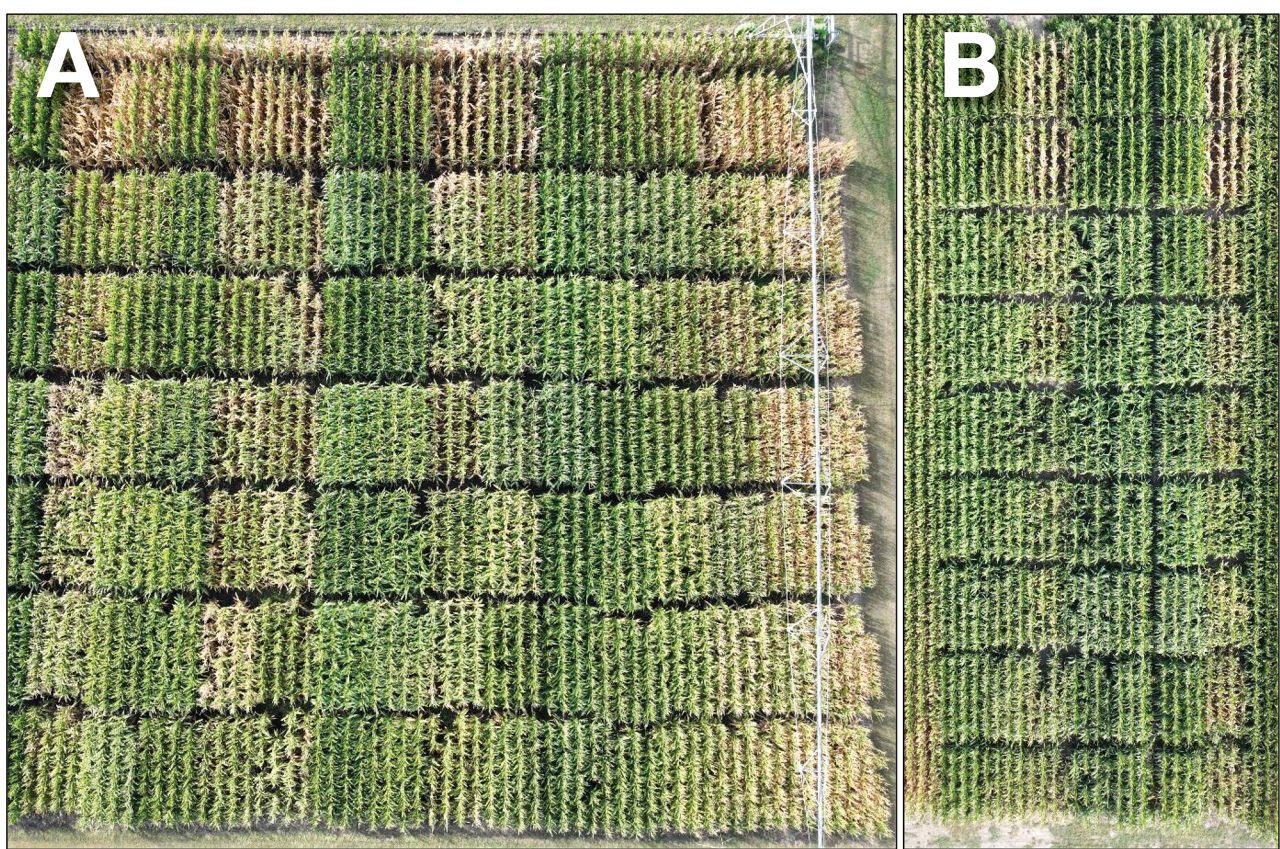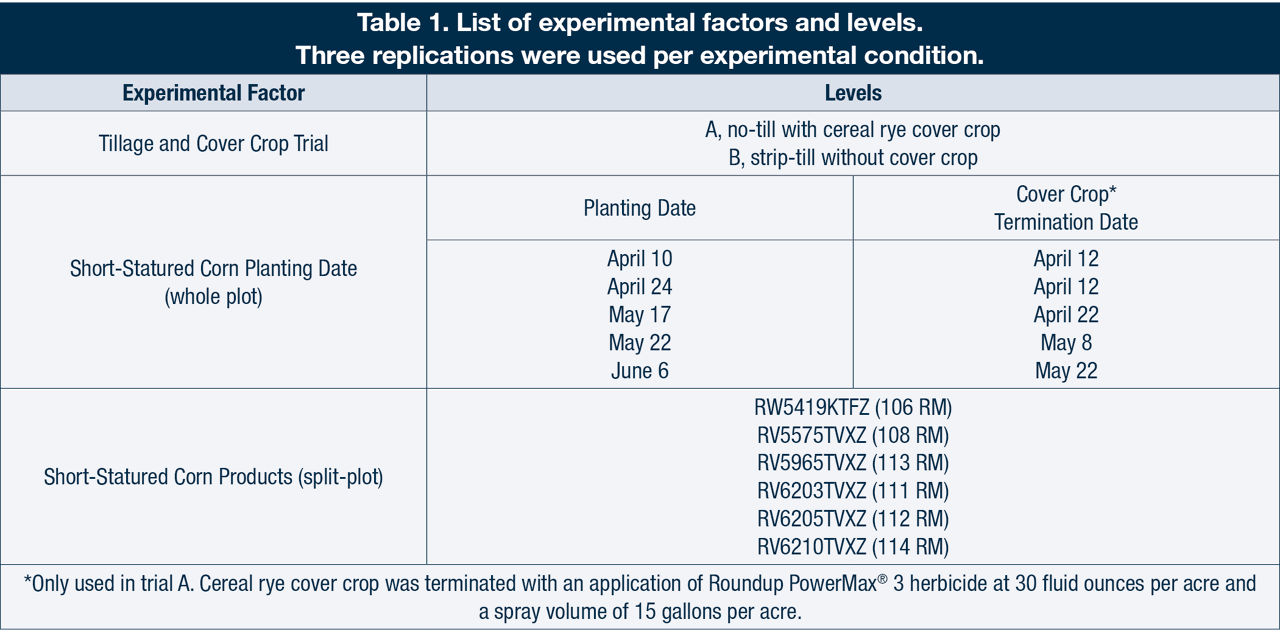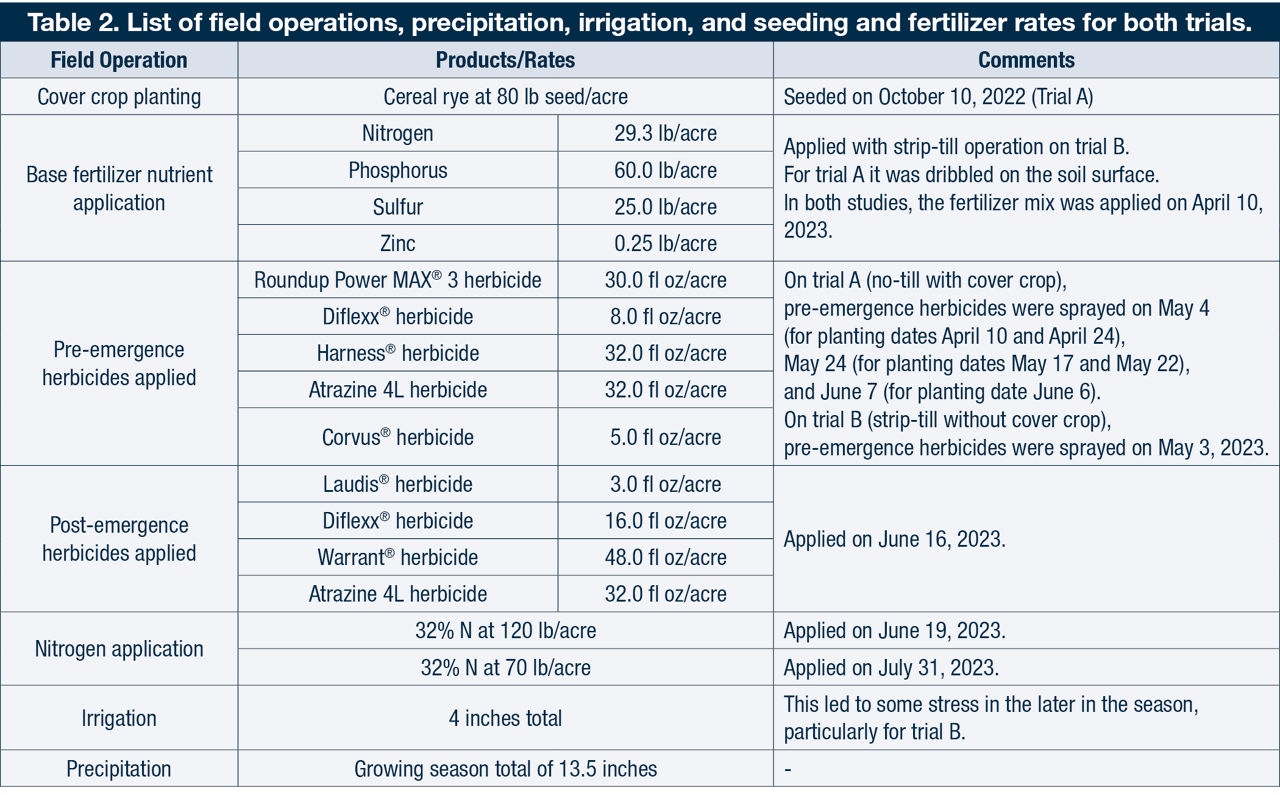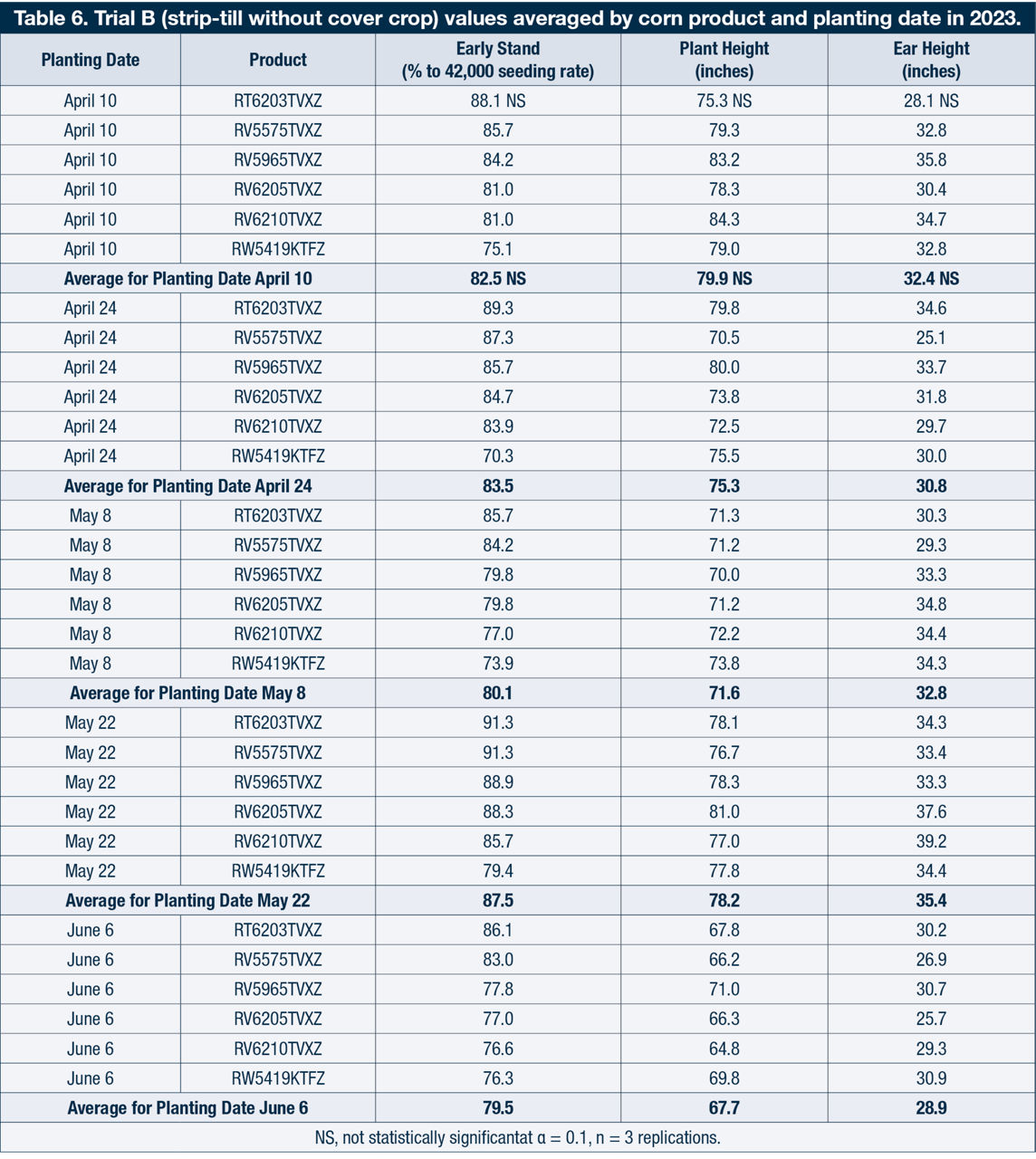Effect of Planting Date and System on Short-Statured Corn Products
July 1, 2024
TRIAL OBJECTIVE
- Short-statured corn is a new corn breeding innovation that is part of the Bayer Preceon™ Smart Corn System which is planned to be commercially available for planting in the 2025 growing season via the Ground Breakers® program.
- The product concept for short-statured corn is to provide high-yielding corn with shortened internode distances (area between leaves) that can result in shortened plant height. Short-stature corn will typically have a maximum height of seven feet and corn ear placement of at least two feet above the soil.
- Short-statured corn may perform differently according to planting dates, tillage method, and cover crop use. One of the main characteristics of interest is the ear height, and if that would affect grain yield.
- The objective of these studies was to determine how planting date and tillage method affect early corn stands, plant and ear height, and grain yield of short-statured corn products.
RESEARCH SITE DETAILS


- The study was arranged in a split-plot design with three replications and three treatment factors according to Table 1.

- Field operations, seeding rates for the cover crop and corn, fertilizer nutrients and rates applied, and the amount of irrigation water applied are listed in Table 2.

- Cereal rye cover crop biomass was collected at the time of termination, and total soil residue coverage was measured using the SRPNet web app from Kansas State University.
- Early stand counts, plant heights, and ear heights were measured during the growing season.
- Plots were combine-harvested and grain moisture content, test weight, and total weight were collected. A Fisher’s Least Significant Difference statistical test was performed to determine if significant differences occurred.
UNDERSTANDING THE RESULTS
- The cereal rye cover crop was terminated at the time of short-statured corn planting for the April 10 planting date because the cover crop biomass was low (148 lb/acre).
- For all the other planting dates, the cover crop was terminated at least 2 weeks prior to short-statured corn planting to minimize any detrimental effects to nitrogen immobilization, water use, and grain yield.
- The corn in Trial B (strip-till without cover crop) suffered from more moisture stress season-long (Table 2), which may have contributed to the lower yields in that trial.
- An overview of the cover crop biomass by May 25, 2023, is available in Figure 2.

- Cereal rye cover crop growth was accelerated in late May, creating higher biomass accumulations by the short-statured corn planting dates of May 22, and June 6 (Table 3).
- A similar increase was found for soil residue coverage. However, it is noticeable that soil residue coverage was reduced from May 11 to May 25 as the decomposition process accelerated with warmer temperatures and precipitation (Table 3). Only the May 17, May 22, and June 6 planting dates had a soil coverage percentage above 50% after May 25 (Table 3).

- In both trials A (no-till with cover crop) and B (strip-till without cover crop) the short-statured corn early stands were not affected by planting date or product (Tables 4 and 6).
- There was a significant interaction of short-statured corn planting date and corn product on plant heights in trial A (Table 4).
- Short-statured plant heights varied from 85.5 (RV6205TVXZ planted on May 17) to 59.5 inches (RV6205TVXZ planted on April 24) in trial A.
- Corn products RT6203TVXZ and RV5965TVXZ produced significantly taller average plant heights than corn products RV6205TVXZ, RV6210TVXZ, RW5419KTFZ, and RV5575TVXZ . Corn products RV5575TVXZ, RV6210TVXZ, and RW5419KTFZ produced the shortest average plant height (Table 5).
- There were no significant effects of planting date or corn product on plant heights in trial B (Table 6).
- The short-statured corn products in this trial had higher average plant heights (74.5 inches) in trial B (strip-till without cover crop) compared to trial A (70.9 inches, no-till with cover crop) when averaged across all planting dates and products (Tables 4 and 6).


- There was a significant interaction of corn planting date and product on ear heights in trial A (Table 4).
- Short-statured ear heights varied from 40.6 (RV5965TVXZ planted on June 6) to 24 inches (RV6203TVXZ planted on May 17) in trial A. In trial A, The highest average ear height occurred in corn products planted on June 6, whereas lowest average ear heights occurred in corn products planted on May 22 (Table 4). There was no effect of short-statured corn product on ear height (Table 5).
- There were no significant effects of planting date or corn product on ear heights in trial B (Table 6).
- When averaged by corn product and planting date, the planting date that produced the largest ear height varied between trials A and B. In trial A (no-till with cover crop), the largest average ear height occurred in corn products planted on June 6 (35.2 inches). While in trial B (strip-till without cover crop), the largest average ear height occurred in corn products planted on May 22 (35.4 inches). This difference in the effect of planting date on ear height may have been due to the cover crop biomass accumulation, which increased shading and thus promoted plant etiolation during the early growth stages.


- There was a significant effect of planting date on short-statured corn grain yield in both trials. In both trials A and B , yields were greater on May 17 and May 22 compared to April 10 and June 6 (Figure 3).
- In trial A, the June 6 planting date produced significantly lower grain yields. This difference may have been due to the cover crop immobilizing nitrogen and using water. In both trials, average yield appeared to increase from April to May planting dates and then decrease from May to June planting dates (Figure 3).
- In general, short-statured corn grain yields were greater under no-till with cover crop compared to strip-till without cover crop. This was different than the 2022 trial where the no-till with cover crop treatments generally had lower yields than those of the short-statured corn planted with strip-till and no cover crop. In 2022, cover crops were terminated at the timing of corn planting, whereas in 2023 cover crops were terminated at least 2 weeks before corn planting (except for the April 10 planting date, Table 1).

KEY LEARNINGS
- When using grass cover crop species like cereal rye, the cover crop should be terminated at least two weeks prior to short-statured corn planting. Too much cover crop biomass accumulation such as that which occurred with the June 6 planting date (4010 lb/acre) may be harmful to corn, potentally due to nitrogen immobilization and soil water use.
- Short-statured corn plant height and ear height seem to respond differently to planting dates under no-till with cover crop, and under strip-till without cover crop. Further investigation is needed to better position products on those tillage systems.
- Cover crops, if well managed, could have a beneficial effect on yield potential in the novel short-statured corn system.
- As found in previous studies, short-statured corn grain yield seems to benefit from a mid- to late-May planting date at the Gothenburg Learning Center.
1210_219611